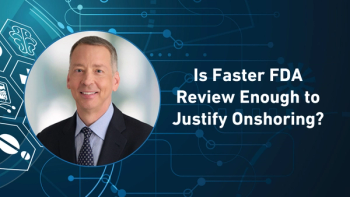
- Pharmaceutical Commerce - November/December 2017
Pre-approval access and real-world evidence: a win-win proposition
The introduction of new therapies coupled with a sense of entitlement to them continues to generate great interest in earlier access to experimental medicines. Generating real-world evidence from pre-approval access programs could present a win-win situation for all stakeholders involved.
Pre-approval access programs, also known as expanded access (EAP) and compassionate use (CU), are complex and encompass many moving parts. These include ethical concerns such as patient safety and equity of access, manufacturing scale-up, and other resource challenges. Despite FDA efforts to assuage fears, not everyone is convinced that adverse events (AEs) discovered in a sicker, expanded access population will not ultimately impact regulatory approval. So, while these programs have existed for decades, some insist that the existing systems are too slow, are fraught with regulatory red tape, and, through “right to try” legislation, that patients should have the right to get access to any medications they believe will help them (see box).
A source of real-world evidence
The intent of the FDA’s Expanded Access (Compassionate Use) regulations and guidance documents is to provide earlier and increased access to experimental treatments to patients with serious diseases, not just to conduct research. Therefore, only minimal safety data collection is currently required. Efficacy and other data can be collected, but does not need to be submitted to FDA.
Legislative requirements contained in the 21st Century Cures Act, along with commitments negotiated between the pharmaceutical industry and FDA, as part of the sixth Prescription Drug User Fee Act (PDUFA VI), defines real-world data (RWD) as data collected outside of a randomized clinical trial (RCT). The legislation requires FDA to develop and implement a framework for application of real-world evidence (RWE) to establish efficacy by 2019. The convergence of these two concepts, pre-approval access and real-world data collection, could represent a “win-win” situation for patients, regulators and companies.
RWE comes from the analysis of real-world data (RWD). This data can include observational studies, registries, retrospective database studies, case reports, administrative and healthcare claims, electronic medical records, and pragmatic trials conducted on a broad patient population in routine clinical practice. This RWD can be generated faster and at a much lower cost than in a randomized clinical trial.
Patients in a pre-approval access program are often more representative of those patients who will likely be some of the first patients to take a new drug once it is approved. Pre-approval access patients, by definition, do not meet the entry criteria for a clinical trial. They frequently have been pre-treated, have more co-morbidities, are more advanced in their disease and are generally in poorer health than those in a clinical trial. RWD collected from those patients in a pre-approval access program, in conjunction with clinical trial data, could add value by:
- Creating greater precision and clarity as to the safety and efficacy profile of new products, thus improving the labeling and approved indications of products
- Improving the amount and quality of information available to patients and physicians, leading to more informed decisionmaking about new products
- Demonstrating benefit: Examination of real-world use of products may accelerate the rate at which products prove their value to patients, providers and payers, supporting reimbursement with real-world evidence (demonstrating benefit)
- Better identifying symptomatic toxicities that could have a significant impact on adherence and are a major contributor to treatment discontinuation
- Allowing further dose/side effect exploration in conjunction with the drug’s clinical trials before drug approval, leading to better information in labeling about appropriate dose without unduly delaying a drug’s approval
The case is especially compelling for rare conditions that have no effective treatments, as well as in circumstances when a randomized, controlled clinical trial is ethically impossible. It also can apply to more common indications, especially to generate safety data and demonstrate efficacy about supplementary indications.
Additionally, the idea that data from pre-approval access programs can be used to support regulatory decisions is not speculative. The most dramatic example is the FDA’s 2015 approval of Vistogard (uridine triacetate) from Wellstat Therapeutics Corp., based entirely on pre-approval access data on 135 patients. It was approved as an antidote to overdosing and to treat certain severe or life-threatening toxicities from chemotherapy.
FDA continues to seek the answer to the question “How can RWE better support regulatory decisions?” At two workshops in September—convened by the National Academy of Sciences (NAS) and the Duke-Margolis Center for Health Policy at Duke University—FDA leadership, biopharmaceutical executives, payers and providers met to begin to identify the barriers to utilization of RWE in regulatory decisionmaking. They also began to layout a path forward to transition from conceptual approach to practical application.
Utilizing RWE will require collaboration, change and investment from every sector of healthcare stakeholders. Regulators, with collaboration from drug developers and payers, will have to formulate standards for RWD collected on patient health status and/or the delivery of healthcare, from a variety of sources. Biopharma companies will have to obtain or develop the expertise needed to design and implement RWE studies and engage in precompetitive collaborations to define best practices.
The Duke-Margolis meeting generated a white paper,
Generating RWD from pre-approval access programs, combined with companion registration clinical trials, could create valuable infrastructure for RWE demonstration projects, and at the same time, provide greater, earlier access for patients to experimental medicines—a win-win for all stakeholders concerned.
ABOUT THE AUTHOR
Jane Reese-Coulbourne is a senior consultant at MK&A (
‘Right to try’ legislation and EAPs
The desires of sometimes desperate patients for access to experimental medicines are most evident in the success of the Goldwater Institute in passing “right to try” (RTT) legislation in 38 states, along with current federal legislation under consideration. These laws imply that patients can obtain access to any experimental medicine and promote the idea of creating an alternative pathway, allowing patients to get access under any conditions without any FDA oversight. In practice, RTT laws have not to date provided any additional access to patients. The final decision on whether or not to give patient access to a not-yet-approved medication still remains with the sponsor.
The focus of most of the federal legislation has been on finding ways to incentivize manufacturers to agree to provide earlier access to experimental medicines to seriously ill patients. Making use of strong support from the Trump Administration and some members of Congress, supporters of federal RTT legislation have been successful in passing legislation in the Senate, while the House decision is pending. Elements of RTT have also been successfully included in other federal legislation, namely the 21st Century Cures Act and Prescription Drug User Fee Act (PDUFA), as well as in the Final Rule. However, despite all of this legislative work, many key issues have not been resolved, or even addressed, in these laws.
In response to demand for earlier access, FDA has taken several steps to streamline and clarify its policies aimed at reducing “procedural burdens on physicians and patients.” These include clarification of requirements for expanded access for both individual patients and for intermediate and large-scale studies, affirmation of the need for minimal institutional review board (IRB) review of protocols—even in cases of emergency use—and a narrower requirement for adverse event (AE) reporting. Addressing sponsors’ concerns that AE reports could derail development efforts, FDA has stated that FDA reviewers are to interpret safety data in “the context in which the expanded access use was permitted.” The agency has even published data it believes should dispel fears about regulatory risk. FDA continues to try to minimize this regulatory risk as a barrier by further clarifying its position and encouraging manufacturers to create pre-approval access programs.
Articles in this issue
about 8 years ago
The changing paradigm in primary packaging of therapeutic proteinsabout 8 years ago
Traceability end-of-year updateabout 8 years ago
Big Pharma requires big help in protecting CRT productsabout 8 years ago
Deloitte and Cardinal Health team up for patient support servicesabout 8 years ago
Managing pharma auto fleetsabout 8 years ago
A conversation with Jim Cleary, AmerisourceBergenabout 8 years ago
If CVS Health-Aetna doesn’t happen, something else willabout 8 years ago
123 countries participate in Pangea X to fight counterfeit drugsabout 8 years ago
Bridging gaps in communicating with patientsNewsletter
Stay ahead in the life sciences industry with Pharmaceutical Commerce, the latest news, trends, and strategies in drug distribution, commercialization, and market access.





